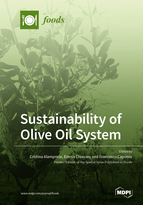Sustainability of Olive Oil System
A special issue of Foods (ISSN 2304-8158). This special issue belongs to the section "Food Security and Sustainability".
Deadline for manuscript submissions: closed (30 April 2021) | Viewed by 66328
Special Issue Editors
Interests: food science and technology; oils and fats; IR spectroscopy; chemometrics; food structure; food process modelling; food product design; design of experiments
Interests: technology of oils and fats; physicochemical and thermal processing of food
Special Issues, Collections and Topics in MDPI journals
Interests: olive oil; food by-products; bioactive compounds; polyphenols
Special Issues, Collections and Topics in MDPI journals
Special Issue Information
Dear Colleagues,
Sustainability, defined as ‘meeting current needs without compromising the future’, is a widely accepted goal across many sectors of our society. Sustainability criteria and indicators often regard only sustaining the present conditions through increased resilience, intended as the capacity of a system to experience shocks while retaining essentially the same functions and structures. However, new concepts of sustainability, sometimes referred to as “sustainagility”, consider also the properties and assets of a system that sustain the ability (agility) of agents to adapt and meet their needs in new ways, preparing for future unpredictability and unforeseen changes. Therefore, resilience must coexist with adaptive capacity for real long-term sustainability.
Consumers pay more and more attention to the sustainability of the food supply chain; thus, sustainable development is a need for all food processes. In particular, since the olive oil sector has a well-established historical tradition, any change and innovation aimed at obtaining a sustainable development needs not only to be analyzed in terms of environmental, economic, and social aspects, but also to be significantly improved and closely monitored. Thus, the main goal of this Special Issue is to collect papers able to increase sustainability knowledge in the olive oil processing chain, in order to move a significant step forward in future developments.
Prof. Dr. Cristina Alamprese
Prof. Dr. Emma Chiavaro
Prof. Francesco Caponio
Guest Editors
Manuscript Submission Information
Manuscripts should be submitted online at www.mdpi.com by registering and logging in to this website. Once you are registered, click here to go to the submission form. Manuscripts can be submitted until the deadline. All submissions that pass pre-check are peer-reviewed. Accepted papers will be published continuously in the journal (as soon as accepted) and will be listed together on the special issue website. Research articles, review articles as well as short communications are invited. For planned papers, a title and short abstract (about 100 words) can be sent to the Editorial Office for announcement on this website.
Submitted manuscripts should not have been published previously, nor be under consideration for publication elsewhere (except conference proceedings papers). All manuscripts are thoroughly refereed through a single-blind peer-review process. A guide for authors and other relevant information for submission of manuscripts is available on the Instructions for Authors page. Foods is an international peer-reviewed open access semimonthly journal published by MDPI.
Please visit the Instructions for Authors page before submitting a manuscript. The Article Processing Charge (APC) for publication in this open access journal is 2900 CHF (Swiss Francs). Submitted papers should be well formatted and use good English. Authors may use MDPI's English editing service prior to publication or during author revisions.
Keywords
- sustainability
- olive oil
- biodiversity
- environment
- economics
- green chemistry
- byproducts
- innovation








